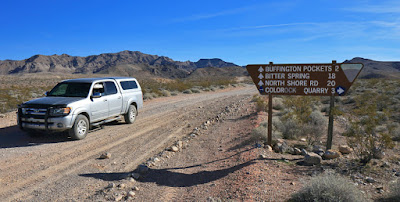I'd been to Khota Circus about 2 years ago, and at the time I didn't know where it was, so I spent a lot of that time wandering around, trying to find it. In fact, it may be hard to believe when you see the actual panel below, but I went right past it! But this time I remembered exactly where it was --
This main panel is over 90 feet long and is the longest rock art panel in Nevada. It's called a "circus" for the variety of animals represented on it -- Ants, lizards, snakes, birds, turtles,and others. And it's somewhat unusual among petroglyphs in that it's right at eye level, so you can examine it close up. Here's a closer view of the main panel, though there are still figures out of this view both to the right and left; this is a panorama of 5 photos --
The current speculation is that the area of Khota Circus wasn't a site of human habitation, but rather used for ceremonial purposes; there is a similar area on the other side of the Moapa Valley's Muddy River. And the panel is possibly a scene of mass migration; in the top of the panel the animals are moving to the right, and in the bottom, to the left.
In the photo below, the figures to the right of the large Desert Bighorn Sheep are lizards, and between them is possibly what is known as a "burden basket", designed by the native peoples to ease the burden of a heavy load. For some reason, it looks like it's upside down --
A creature from outer space? No, it's more likely an ant --

And though you can't see it, there's a hummingbird off to the left.
Some of the anthropomorphs (human-like figures) are quite mysterious. What's the meaning of the humanoid figure on the left, with the spiral-like designs coming out of his head?
I've seen footprint -- and hand -- petroglyphs in other areas like Grand Gulch in southeastern Utah. In my reading online about rock art petroglyphs I've come across some pretty "far-out" ideas for these, and the bottom line is we'll never know for sure --
Here's a small animal, possibly a fox --
That's a bird's foot on the upper left, and a smaller one to the left of that -- but the human-like figures connected at the hip? --
Here's another possible lizard. I took this photo when the sun was on the panel, so you can see more of the actual pecking and chipping used to create these figures.
This is probably an eagle --
And the animal to the right looks to be a deer; it has a large rack of antler points, where the bighorn sheep have only the 2 horns. But why is the deer figure connected by a line to the spiral?
Here are a flock of geese, as seen flying in formation --
The actual panel of Khota Circus is impressive enough. But on the canyon wall to the right of the Circus, in an area which looks to be nearly inaccessible, are clearest and most precise petroglyph figures that I've ever seen. They literally look as it they were created yesterday --
Here's a closer look --
And still closer. These photos were taken with my 100-400 lens, essential for viewing the details when they're so high up on the wall. From what I've read on the Internet, the figures with what looks to be an "H" are more burden baskets, and "H" is a bat clan symbol. There's also a snake, a reclining flute player (similar to Kokopelli, a universal fertility god) that is above the third basket from the left, crosses with circles, more spirals. It's amazing to see something so old -- at least 500 years or more -- in such pristine condition --
On the smaller panel to the left of the main one, there are more sheep, another burden basket with an "H", and more spirals. There is speculation that the burden baskets,when pointed up, means they're full, and there is plenty to eat. When they're pointed down, they're empty, and the tribe goes hungry. Or at least that's one of the theories..
The top figure in the next photo is possibly a tree of life, and there's also another anthropomorphic and at cross with spirals at each end --
The truth is -- well, we don't know the truth for sure. It may be a story about the journeys that must be made due to the lack of rain, which makes sense in this desert land. Migrations of peoples and sheep, full and empty baskets, flute players representing fertility, creatures seen in the desert -- their exact meaning is mostly speculation. I remember reading somewhere that the mind of the average person living in Europe in the Middle Ages was alien to our way of thinking, because every facet of life back then was based solely around religion in a way that is unfathomable to us. I think the same holds true to the ancient peoples of this area in southern Nevada, indeed in the Southwest; they truly are a "riddle wrapped in a mystery inside an enigma". And perhaps that's the way it should be...






















































